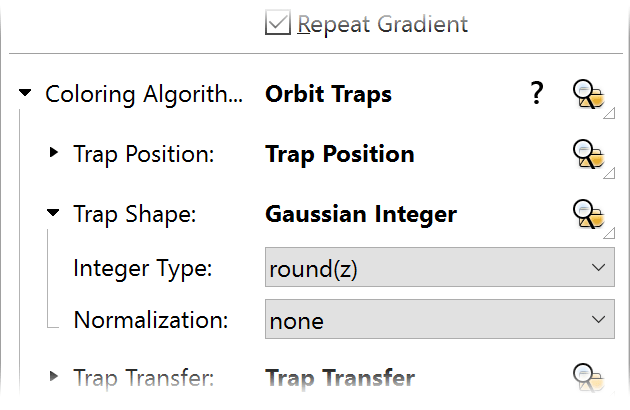
Click the Browse button in the Outside tab of the Layer Properties tool window to select Plug-In Coloring (Gradient) in Standard.ucl.
| Tip: This example assumes that you are familiar with Ultra Fractal basics as explained in the tutorials. |
In the previous example, we saw how a formula plug-in can implement the behavior of an entire fractal formula. However, it's also possible to use plug-ins in a more fine-grained way, exposing all aspects of a formula for maximum flexibility.
The Orbit Traps coloring plug-in is an example of this. The old Orbit Traps coloring algorithm (still available in Standard.ucl) contained parameters such as trap shape, trap mode and trap coloring, each with a number of options. In the new version, implemented as a coloring plug-in in Standard.ulb, these are now plug-in parameters. Every major option is now handled by a separate plug-in. Let's have a look:
| First, use the browser to open the Default parameter set in Examples.upr. | ||
 |
Click the Browse button in the Outside tab of the Layer Properties tool window to select Plug-In Coloring (Gradient) in Standard.ucl. |
Like Plug-In Formula, Plug-In Coloring (Gradient) is a skeleton coloring algorithm that lets a coloring plug-in do the work. By default, it loads with the Smooth algorithm.
 |
Click the Browse button for the Coloring Algorithm parameter to select the Orbit Traps plug-in in Standard.ulb. |
As you can see, the Orbit Traps plug-in uses plug-in parameters for all major parameters. All trap shapes, for example, are now implemented as separate plug-ins. Let's select a different trap shape.
 |
Click the Browse button for the Trap Shape parameter to select the Gaussian Integer plug-in. |

The old Gaussian Integer coloring algorithm in Standard.ucl actually is a variation on an orbit trap, just with a different trap shape. It had limited options to color the trap shape, but now that it is available as a general trap shape plug-in, we can combine it with any trap mode or trap coloring.
For example, you can select Angle to Origin 2 as the trap coloring to get an effect that you couldn't create with the original Gaussian Integer coloring algorithm.
When formula authors write new trap shapes, trap modes or trap colorings and make them available in plug-in library files via the public formula library, you can just drop them into this standard Orbit Traps plug-in to use them.
Next: Working with plug-ins
See Also
Plug-ins
Coloring algorithms
Writing formulas